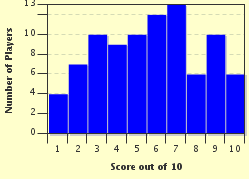Quiz Answer Key and Fun Facts
1. The percussion instrument pictured here is played by striking the bars with mallets and is as close as we'll get to a xylophone. Developed in Central America from a native instrument brought to the New World by African slaves, what type of instrument is this?
2. We continue with another percussion instrument. Originating in Mali and played with bare hands, what is this rope-tuned, skin-covered, goblet drum?
3. Carved from a single block of red cedar, the sound of this short-necked, bowed, stringed instrument is said to resemble the human voice. Native to India and often used in classical Hindustani music, what is this instrument?
4. Originating in India, this double-reed, wind instrument is the world's loudest non-brass, acoustic instrument. It can be heard just about any Hindu wedding and is often used in the temples of southern India. Usually played in pairs and accompanied by drums called 'thavil', which instrument is this?
5. What common factor is shared by the ektara, the ichigenkin, the psalmodicon (pictured) and the tumbi?
6. This Ukranian folk music instrument has elements of both a zither and a lute. Once called a 'kobza', it originally had either six or twelve strings. Modern versions have 31 strings and occasionally as many as 68. What is this plucked-string instrument now called?
7. The instrument pictured here is one of the few metal-strung instruments that originated during the Renaissance period. During the 16th-18th centuries you might find one of these sitting in a barber shop, available for customers to entertain themselves whilst awaiting their turn in the chair. What is this popular British folk music instrument?
8. Dating back to the 15th-century, this high-pitched, flute-like, bamboo instrument is commonly used in Japanese Imperial Noh and Kabuki theatre. With a range of two octaves, what is this instrument?
9. Dating back at least 3,500 years, the trumpet is one of the best-known instruments in the brass family. Today. a trumpeter is one of the most important members in any respectable jazz band. Which of these great musicians is NOT specifically known as a virtuoso trumpeter?
10. This instrument, classified as a 'brass aerophone' by musicologists, dates back at least 1,500 years. Effectively a natural wooden trumpet, it is sometimes called a "drone pipe". What is this hard-to-play wooden instrument?
Source: Author
EnglishJedi
This quiz was reviewed by FunTrivia editor
kyleisalive before going online.
Any errors found in FunTrivia content are routinely corrected through our feedback system.


